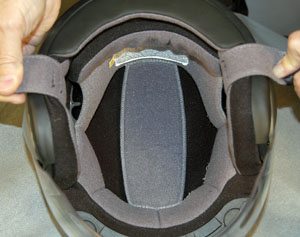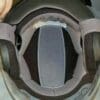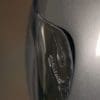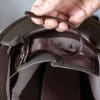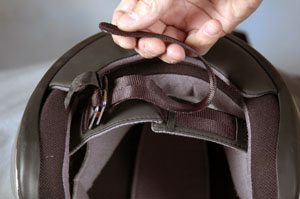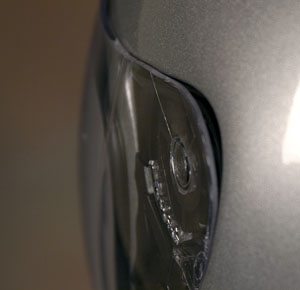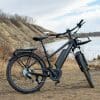The Zamp JS-1 is a nice-looking open-face helmet.
It offers a decent level of quality; certainly not the best, but we’ve seen much worse for more money.
There are so many motorcycle helmets to choose from — so many styles, colors and types. How to pick one for a review?
We’ve focused mainly on reviews of full-face helmets because they are the type most frequently worn by webBikeWorld visitors.
But a recent ride behind a great big fairing on a friend’s Gold Wing got me thinking about alternatives.
That’s when I found this Zamp JS-1 open-face helmet for only $69.99 brand spanking new. It has labels proclaiming U.S. DOT and Snell approval, and sure enough, a quick check of the Snell listing of certified helmets confirms that it does indeed meet the Snell M2000 certification.
We’ve always been puzzled at how an open-face helmet can pass Snell certification tests when after all these years, not a single flip-up helmet has been approved, yet many of them meet the tough European ECE 22-05 safety standard. Flip-up helmets legally sold in the U.S.A. do meet DOT approval, however.
We happen to know for a fact that at least one flip-up did pass Snell certification once — we have a copy of the official test, which was performed at a Snell-approved lab, and the helmet passed with flying colors.
The manufacturer had all good intentions of selling the helmet in the U.S.A., but they stumbled trying to break the arcane U.S. distribution system and they also ran into some manufacturing capacity issues, which has so far completely stalled the entire process.
Nevertheless, open-face helmets can meet Snell certification standards, and the JS-1 is on the list. Zamp helmets are made in China, which now manufacturers many other brands of motorcycle helmets, including some well-known labels that one wouldn’t necessarily associate with that country.
Zamp JS-1 Motorcycle Helmet
Zamp distributes a limited number of helmet models in the U.S., and although the Zamp name isn’t as recognizable as some of the big-bucks market dominators, the JS-1 and others can be found online and (according to our sources) also through selected Kawasaki dealers. Kawasaki is one of the U.S. distributors for Zamp helmets.
How much of a helmet does one get for $69.99? In addition to the DOT and Snell certification, the JS-1’s non-removable liner is relatively comfortable (see Photo 3 below).
The fabric is only slightly less plush than helmets costing many hundreds of dollars more. The quality of the liner and the care taken with its installation in the helmet shell is actually better than several other much more expensive helmets we’ve tried recently.
Open-face helmets seem to have a more liberal fit; that is, they seem to fit a wider variety of head shapes for any given size, but our opinion is that the Zamp JS-1 is generally designed to fit round and earth shaped heads. See the wBW Motorcycle Helmet FAQ page for more information on head shapes and helmet fitment.
The JS-1 has relatively large ear pockets, and the back of the pocket towards the shell is unlined, which may make this helmet a good candidate for speaker installation. I think it would also be very easy to attach a microphone to one side of the helmet, making the JS-1 a good candidate for an all-around touring bike helmet.
Helmet Weight
The helmet feels heavy for an open-face style, weighing in at 1497 grams (3 lbs., 4-3/4 oz.) for a size XL. This is heavier than two of the full-face helmets we’ve reviewed (see the new wBWMotorcycle Helmet Weights comparison page for more information).
The JS-1 also sits slightly high on the head and the bottom of the helmet feels like it should be lower, which takes some getting used to.
The padded cushions that extend from either side of the helmet and which are designed to prevent the strap from cutting into the rider’s chin and neck are also very thin and not nearly long enough to serve their purpose.
Also, the chin strap seems extra-long and it does not include any “hook and loop” fastener, snap or other methods to keep the end secured.
So the extra piece must either be tucked under the secured portion of the chin strap, adding to the discomfort, or left flying in the breeze. There is a small rubber band-like donut around the D-ring that is supposed to help retain the extra strap, but it’s basically useless.
Another quirk is that the D-ring has a thin piece of material that is designed to allow the user to easily grab one of the D-rings if necessary.
But we found that it’s located in a position that causes it to flap about vigorously when underway, causing a very annoying buzzing feeling.
I actually thought a bee had become tangled in the chin strap the first time I tried the helmet, and I had to keep from panicking as I furiously tried to dig it out!
Face Shield
The JS-1 has a huge face shield, which is a real plus. I’d forgotten how much visibility one has when wearing an open-face helmet compared to a full-face style.
Riders should have no problem seeing the instruments or the map on the tank back with this helmet!
The face shield also has four strong detents, allowing it to be pushed up into a variety of positions.
The detents are strong enough to hold the face shield in position at reasonable speeds, although the wind can catch underneath at higher velocities if the face shield is set in anything but its lowest position.
However, the face shield has many ripples and shows some distortion across the front.
It’s something the rider can get used to, but it’s annoying. It would be better for Zamp to spend a few extra bucks and put a decent face shield on this helmet.
The helmet’s shell includes an O-ring type gasket across the entire opening, and the face shield does seal tightly against it. The face shield is easily removable, using the typical quick release system found on many other motorcycle helmets lately.
The rear edges of the face shield, located behind the pivot point, are slightly warped on our example, and they don’t fit tightly into the face shield recess in the shell (see Photo 2 above).
Noise Levels
We think this is one of the sources of wind noise in the JS-1. The wind comes up under the face shield and along each side of the face. At certain speeds or with a cross wind, the turbulence caused by this air flow causes my eyelids to flutter, which is very annoying and borders on painful.
Noise levels are a real problem with the JS-1 when it’s used behind anything but a full fairing. There’s no doubt about it – this is one noisy helmet, probably due to a combination of the design, the face shield shape and the shortness of the helmet around the neck area.
We always wear correctly installed earplugs when riding; see the wBW Earplugs and Hearing Protection page for more information on choosing and wearing earplugs. But even with earplugs, this helmet is very noisy on both “naked”, or unfaired, motorcycles and when used behind smaller fairings or windscreens.
The helmet is slightly less noisy when riding sans fairing, but on half-faired bikes, like the Triumph Tiger or a Suzuki Bandit 1200, the turbulence hitting the JS-1 can cause a tremendous racket, even causing the helmet to shake and vibrate at certain angles of attack.
The noise levels are acceptable when used behind a big, full-length fairing like the Gold Wing; thus, we can only recommend using the JS-1 for touring.
Ventilation
The JS-1 has two vents, located on the top front of the helmet. A small plastic switch opens or closes a cover over the vent hole, and the switches feel flimsy and don’t completely cover the holes on our example.
There are also two exhaust vents on the top rear of the helmet, which can also be opened or closed using the same style of switch lever. We noticed no difference, whether the vents were opened or closed. Most of the air comes in under the face shield anyway, and the vents are probably there more for show than for function.
Conclusion
The Zamp JS-1 is a nice-looking open-face helmet. It offers a decent level of quality; certainly not the best, but we’ve seen much worse for more money.
The combination of DOT and Snell certification is a plus. But the opinion around here is that we’d much rather pay a few bucks more and get a better quality face shield that wasn’t distorted and that fit the helmet shell more tightly. We’re not sure, however, how the noise problem could be solved without a complete redesign.
That said, the helmet does work fairly well when used behind a fairing that’s big enough to pass the air completely over the rider’s head. It also seems like it would be easy to fit a microphone and speaker kit to this helmet, so it may be just the ticket for owners of touring bikes.


